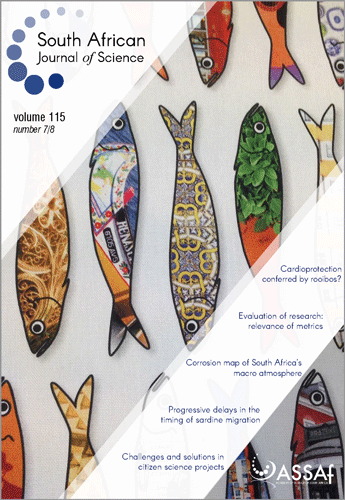An analysis of the effect of tooth wear on bovid identification
DOI:
https://doi.org/10.17159/sajs.2019/5496Keywords:
Bovidae, worn teeth, elliptical Fourier analysis, machine learningAbstract
Previous research provides a method for reducing the subjectivity in taxonomic identification of species in the family Bovidae by quantifying the occlusal surface of molar teeth using elliptical Fourier analysis. In this current study, we specifically test what effect medium to late tooth wear has on the identification of bovids when using the form (size and shape) of the occlusal surface to classify specimens. To achieve this, the classification results of teeth with ≥85% of their occlusal surface (training data set) were compared with the results of teeth with <85% of their occlusal surface (test data set) due to wear. In the training data set, all tribes classified correctly >87% of the time with both Alcelaphini and Reduncini classifying correctly >90% of the time. The worn teeth in the test data set classified correctly at lower rates, but all tribes still collectively had a good classification accuracy (>60%) with classification of Alcelaphini and Tragelaphini at >75% and Reduncini at >65%. Hippotragini classified correctly 50% of the time and Neotragini 42%. The one worn Bovini tooth in the test data set was classified as that of a Hippotragini. The classification rates of teeth with medium to late wear were lower than the unworn teeth, but not so low as to suggest that this methodology for identifying bovid teeth is inappropriate for worn teeth, especially when supplementary to other methods.
Significance:
- Worn teeth can be taxonomically identified by performing elliptical Fourier analysis on the occlusal surface of their teeth.
- While teeth with medium to late wear correctly classify at lower rates than relatively unworn ones, the methodology is a valuable supplement to other methods for taxonomically identifying bovid teeth. Worn teeth of the tribes Alcelaphini and Tragelaphini classify at the highest rates.
Open data set:
Published
Issue
Section
License

All articles are published under a Creative Commons Attribution 4.0 International Licence
Copyright is retained by the authors. Readers are welcome to reproduce, share and adapt the content without permission provided the source is attributed.
Disclaimer: The publisher and editors accept no responsibility for statements made by the authors
How to Cite
- Abstract 944
- PDF 556
- EPUB 227
- XML 378












.png)